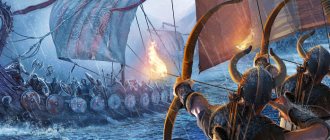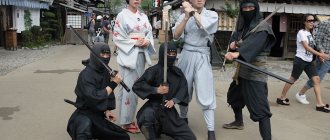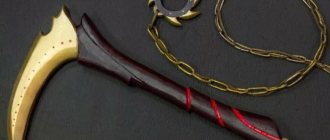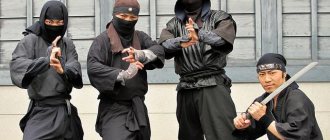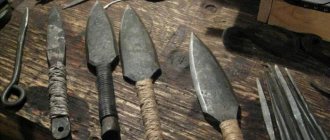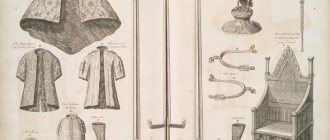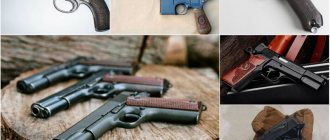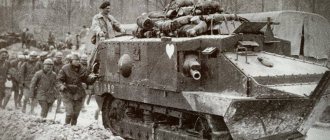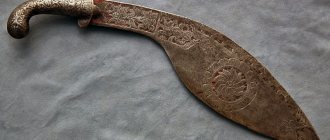Greetings, fans of Japan. What do you know about the mysterious Japanese ninjas? Our imagination draws an image of a nimble man in a black suit, who knows how to fight well, run fast, climb walls and ceilings, and then masterfully disappears into the fog. We got this image of the Japanese superman from films and legends. But who were they really? Today my story is about who ninjas are, the history of their origin, the essence of their work and the qualities necessary to fall into this category of special people.
Who are ninjas
Ninja in Japanese history are a class of killers and spies, spies and mercenaries who have mastered ninjutsu - a method of combat focused on quick victory at any cost. Shinobi spied, deceived, unpredictably attacked the target, using secret methods inaccessible to samurai - for true warriors, “shinobi” is tantamount to abandoning honor. The ninja fought irregular battles, trying to destroy the enemy, and did not hesitate to use any means.
Stories and legends of Japan say that only brave young men were accepted as ninjas. Training began at an early age. Mastering ninjutsu was considered a very difficult task, since the art involves many skills. Those who follow this path are not just warriors, but information miners, capable of attacking with any available objects in a dangerous situation, defending themselves with all available means and even with their bare hands. Ninjutsu includes herbal healing, local medicine, the ability to move unnoticed, instantly hide, as well as acupuncture. Students were trained to hold their breath for a long time or breathe through a straw while under water, climb buildings and rocks, quickly remember what they saw, and navigate in the dark. Since childhood, Japanese spies trained their vision, hearing, smell, all types of memory, and the ability to navigate the terrain.
As among the samurai, ninja clans accept initiation at 15 years of age. Young people studied Zen Buddhism and Xian Taoism, while simultaneously acquiring practical skills.
Mysterious scouts
A person who chose the path of the ninja found himself outside the political system, but part of an independent structured organization. Shinobi were characterized by the word “quinin”, indicating being outside the social structure and the ability to take any place in it.
Initially, most of those who knew ninjutsu lived in Iga, Koga, and Kyoto. The clans accepted wandering warriors - ronins. In the 17th century, there were 70 clans in Japan, dominated by the Koga-ryu and Iga-ryu schools. The class was formed simultaneously with the dominant samurai and terrified both the government and the peasants. Shinobi rarely used combat skills against peasants, because they did not see any benefit in it, and specialized in sabotage and contract killings. Often they pretended to be traveling artists, merchants, and peasants, remaining visible but unnoticed.
How did they appear?
The history of the origin of the caste of Japanese secret agents goes back to the end of the 6th century, when the first mention of spies was recorded. A certain Otomo no Saijin, being a link between the aristocrats and the common people, was in fact a secret confidant of the feudal lord Shotoku Taishi. His task was to appear in the city dressed as a commoner, eavesdrop, spy, and report everything to his employer.
Another famous medieval spy is Takoya, a servant of one of the emperors, who already looks more like a ninja. He masterfully carried out various acts of sabotage, arson and murder.
As a powerful and terrible clan, ninja warriors appeared during the 9th-10th centuries. According to one legend, its basis was the warrior monks Ken Doshi.
Historical documents confirm that the very first place of training preparing professional ninjas was the Iga school. The founders were Buddhist monks who were quite militant. Being persecuted by the state, they went to the mountains, where they improved their skills. The monks were called “yamabushi” (mountain warriors), they were known as healers, dexterous warriors, experts in the art of espionage and trained those who wanted to become real intelligence officers. Yambusi have developed unique techniques to discover the unique capabilities of the human body.
In Japan they believe that ninjas could turn into demons, fly over tall walls and were invulnerable. According to legend, the monks intensively meditated, teaching these skills to future ninjas. Entering a trance, the warriors were reincarnated as a dragon or demon; their altered consciousness helped them do incredible things.
Medieval killers perfectly mastered the art of killing in slow motion, with a light touch. The ninja touched the enemy's body and after a certain time, he died mysteriously. Scientists suggest that simple blows were applied to certain vulnerable points of the human body, which is why death occurred. But how the killers could push it back for some time, no one still knows.
Story
It is impossible to say exactly in what year the history of shinobi begins. Ninjas have been active on the historical scene since the 10th century. They do not form units, act as mercenaries, and do not serve in the army.
Ninjutsu is not a mono-male art. Women practiced it equally with men. The term kunoichi was used for female shinobi.
The heyday of espionage occurred in the 15th-17th centuries, a period of feudal fragmentation. Ieyasu turns to the help of intelligence officers, fighting for power with Toyotomi - the struggle dragged on for 15 years. In 1603, Tokugawa pitted the Koga and Iga clans against each other, fearing that they could harm the ruling structure, and a year later most of the ninja died in civil strife. The survivors pledge allegiance to the shogunate, and their services become obsolete as the Sengoku era ends.
Both men and women were accepted as ninjas
Ninja clans and schools
In the past, there were two ways of espionage in Japan - Ye-ning and Ying-ning. E-nin was used by politicians and warriors, it involved an organized spy network, analysis of information received, and collection of rumors. E-nin in the past was one of the areas of training in the Houses of the ruling families. In contrast to this direction, Ying-ning is closed knowledge. Students were shown good ways to penetrate enemy territory, taught to distract an enemy observer, hide from pursuers, disguise themselves, use poisons and herbs, and covertly kill a target. In-nin is the basis of ninjutsu. Such combat was considered unacceptable for a samurai.
There were about 70 clans in Japan. The most powerful are Iga and Koga in the bordering provinces. The clans adhered to the bansenshukai, but the philosophical views of the heads differed.
Koga's specialty is covert actions, strong poisons, hallucinogens, disguises. Iga are ninjas close to the modern concept of shinobi. They developed combat skills and introduced special training for warriors. The best representatives of the Iga of that time were terrifying killers, capable of using any available object as a weapon or defending themselves from a strong enemy with their bare hands.
The largest shinobi clans are Iga and Koga.
The essence of the concept
I would like to note that the concept of “ninja” simply did not exist in medieval Japan. Such people were called “sinobi no mono.” How did they transform into ninjas? Let's try together to understand the names in more detail and understand who these mysterious ninjas are.
The word “ninja” contains two hieroglyphs:忍者(にんじゃ):
- “nin”忍—“sinobi” means “to hide, hide, do everything secretly”
- "ja"者- "mono" means "person"
Essentially, this is a well-hidden person who does his business secretly. In short, a spy, scout, infiltrator. Don't forget that part of these guys' work was assassination. We conclude that “ninjas” are highly skilled spies with the additional specialization of a killer. They were outlaws, killing and spying for money or for an idea. This closed caste also had its own code of honor.
Preparation
The main idea of shinobi training is to place the student in an aggressive environment to form a flexible reaction to a dangerous situation. This approach is more effective than training under normal conditions: the student better applies the acquired skills and knowledge in a real combat situation, adapts to reality, following the rhythm of reality. Ninja training implied the formation of creative thinking, since only in this way could a warrior quickly determine a non-standard successful way out of a situation, having a limited amount of time and insufficient information.
Ninja training is active-dynamic, aimed at mental and physical fitness. The trainee learned to independently regulate himself, maintaining pace and rhythm, calmness, and a cool mind. For this, “simulators” were used: mannequins, death corridors. This training was consistent with the basics of Zen Buddhism. Each student took it for granted that intuition is preferable to reason, so he learned to cleanse the spirit of experience, formalities, and basic logic. Shinobi were taught to listen to intuitive knowledge, to form a state of high receptivity of the spirit, in which an unexpected situation causes an instantaneous correct reaction.
One of the principles of ninjutsu is respect for the teacher.
Principles of preparation:
- gradualism - increasing loads without haste;
- continuity is a key factor for success, requiring systematic training and daily practice;
- moderation - in nutrition, sensual pleasures;
- prohibition on sexual relations, alcohol, meat;
- self-control - maintaining composure in the most tense situations;
- courtesy - respectfulness, composure, diligence, strict adherence to the instructions of a teacher or elder.
Ninja Ghillie Suit
Historians believe that ninjas did not wear the black, tight-fitting outfits often featured in films, anime, and manga. The best camouflage clothing is brown, ash, reddish, dark gray. In such an outfit, a person blended into the crowd, but an absolute black suit stood out clearly from those around him. During the daytime, shinobi wore ordinary clothes.
The black suit, associated in the popular consciousness with ninjas, comes from the traditions of bunraku puppet theater. A puppeteer sat on stage in this outfit. If, in the story, a character died because of a hired killer, the actor portraying him was dressed in a black puppeteer outfit.
Training
The main weapon of the ninja has always been not the katana and perfect martial arts skills, but deception . Everything else was also enough, they just didn’t have to use their fighting skills as often as one might think. In fact, the shinobi knew everything that could be needed during any part of the conflict. It would not be an exaggeration to call them elite military personnel - special forces of their time.
Ninjas are one of the first professional spies / Photo Pixabay
Ninja training actually began almost immediately after his birth. The cradle of the future James Bond was shaken so that it was slightly but methodically hitting the wall, and the very slightly older little shinobi was periodically twisted and spun in different directions. This is how the vestibular apparatus was trained and ideal reflexes were developed. Next came instruction in reading, science and art. Further proof that the stereotypical image of a ninja has little in common with reality.
One of the main disciplines that each of these guys or girls mastered was chemistry .
- A ninja had to be able to make, say, poison from plants found in the backyard, or make an explosive device on his knee from something he found in the kitchen.
- Shinobi actively used gunpowder borrowed from the Chinese, even when the samurai largely ignored it.
they paid enough attention to banal physical training The recruit was left for several days almost naked in the middle of the snow-capped mountains, where he had to survive relying only on his own skills. While moving, the ninja paid attention to the smallest details - traces, shadows, reflections. All that is now the basis of the work of elite intelligence officers, spies and special forces.
Equipment
The traditional ninja outfit is kuro sezoku; shoes - waraji. Shinobi often dressed in dark blue clothes - they believed that the color drove away poisonous snakes.
Shinobi work clothes are a baggy outfit of a dark gray color, allowing one to blend into the environment.
Ninjas did not wear full armor. If protection was required, a hemispherical helmet was worn, and the most attacked areas of the body were covered with plates.
There is a list of Rokugu - 6 elements of a ninja outfit:
- amigasa (straw hat);
- kaginawa (cat);
- sekihitsu (pencil) or yadate (inkwell);
- yakukhin (first aid kit);
- sanjaku-tenugui (towel);
- uchidake (tsukedake) (pencil case for smoldering coal).
Thanks to the complete set, the warrior could make notes or sketches, a plan, or a mark on the ground at any time.
Ninjas did not wear full armor
